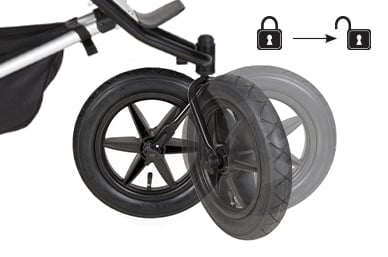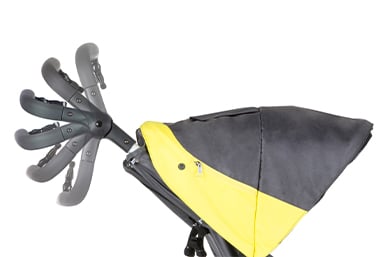The terrain is made to be the runners buggy.
At higher speeds when running, it's normal to have some movement in various parts the buggy. This provides you with some flexibility in where you go, and gives the buggy the chance to adapt to different types of terrain or obstacles should you come across them. Rather than being a rigid piece of equipment with no 'give'.
We do have some tips on how to reduce this level of movement, so you can personalise your terrain to your own preference.
The same can be done, but in reverse, if you find your front wheel doesn't turn as smoothly as expected.
Tip #1
ensure that the front wheel is locked inwards so the wheel faces backward on the buggy. This creates a smaller footprint for the buggy and centralizes the weight load, it should create a smoother ride on flat surfaces.

Tip #2
Above the front wheel there is a cap that can be pried off with a flat screwdriver or blunt kitchen knife. Under this cap there is a nut that holds the front wheel fork onto the stroller. This nut can be loosened or tightened slightly with a socket (quarter of a turn) to allow the front wheel to swivel more freely or track tighter depending on your individual preference. If this is loosened too much, the front wheel can develop a wobble, so this should be loosened in small increments, the same is true for tightening too much. If you tighten in too much you may find it difficult turning the front of the buggy under normal everyday use. But it's up to you.

Tip #3
When jogging some people have the tendency to push down on the handlebar, for support or comfort. This in turn has the effect of lifting the front wheel slightly, like a lever. Try to push the buggy forwards rather than lean down on the handle while running. This will mean the front wheel is not lifting off the ground causing it to flutter.
Adjusting the height of the handlebar so it's a little higher than you may usually have it while strolling, could be a good idea.

